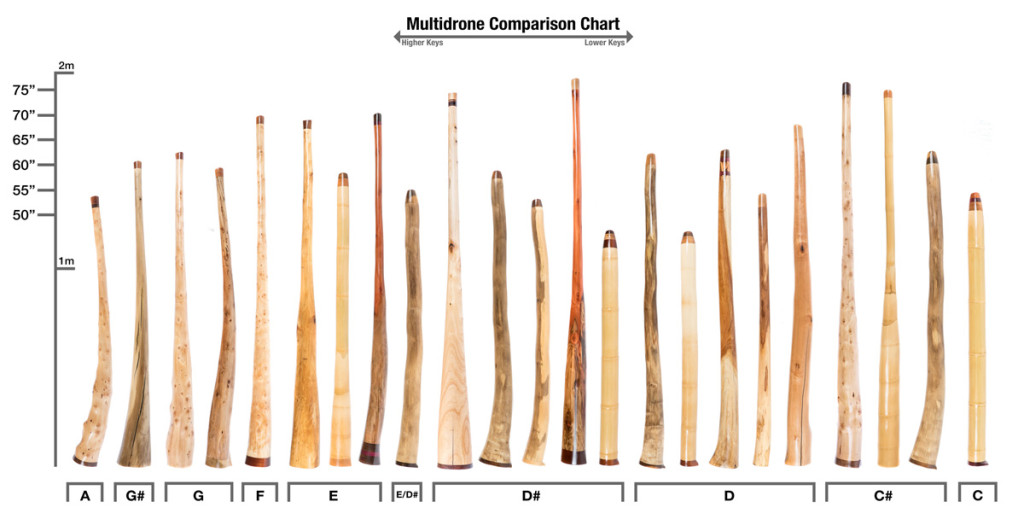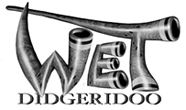Tips on Selecting a Multi Drone Didgeridoos
High Keys: High A, G#, G, F#, F
In regards to learning the multi drone and drop octave techniques, I feel higher keys are easier to drop down an octave. This is because you simply do not have to drop down as far. These pitches typically want to be played faster, and sound better faster because of their naturally high energy. In the multidrone range of high key didges the low notes can be played amazingly fast and carry a lot more energy than the same note produced by a super long didgeridoo. Many people are not accustomed to playing higher keys, so these may seem foreign to normal styles of playing. A very cool feature of some high keys is they make it possible to drop 1.5 to 2 octaves below the fundamental drone. For example, a high G drone can usually drop one octave, and then further to a low C drone below that drop octave. Personally I feel they are the best for quickly developing new levels of lip control and diving into the multi drone technique. This style offers the most unexplored territory for those looking to explore new ranges of sound.
Middle Keys: F, E, Eb, D
These feel more familiar to most players and offer a comfortable start up for the more experienced player who wants to jump into playing what they already know, with the option of getting low. The multi drone notes are more gentle and easy to control in this range. This means the notes between the drop octave and the fundamental don’t take as much pressure to create as they do in the higher keys. The Drop Octave is a little more difficult to hit than it is on higher key didgeridoos, but it is amazingly heavy once achieved. They enjoy being played fast or slow and sound sweet and hypnotizing when the fundamental is played slowly. For experienced players it may be harder to learn the drop octave at first on middle keys because their familiarity can have them distract from allowing something totally new to emerge. For beginners this usually isn’t a problem because the muscle memory has not developed as much to gravitate towards the fundamental drone as a standard.
Low Keys: D, C#, C, B, Bb
Length Consideration for Neck Widths
In the same key, an instrument with a wider neck or bore will usually be shorter than a tight bore instrument. The air column in a tight neck instrument is smaller and thus requires more length to produce the same key as a fat neck instrument. Tight neck instruments are usually more conical. Conical shaped didgeridoos tend to have higher drone keys for their relative length.

Tight, Medium & Wide Neck Didgeridoos
There is no perfect didge. Different shapes make different things possible. Depending on your style you may want to think about choosing a skinny, medium or fat neck. We are speaking here of the internal diameter of the neck, also known as the bore.
- Tight or skinny neck instruments have high back pressure and make it easier to maneuver between a large range of notes. They are best for playing very vast, using lots of trumpet notes and controlling the subtle transitions between multidrone notes. The downside of skinny necks is a loss of richness to the drone notes.
- Medium necks balance the positive and negative characteristics of skinny and wide necks.
- Wide or fat necks produce an amazingly rich drone sound with very crisp harmonic notes. These are great for meditation as well as for players who primarily stay on the fundamental drone note. These are commonly used by many contemporary Australian players. Players who incorporate a lot of “wobble” and beat box sounds often use wider neck didgeridoos. The wide neck provides good projections of subtle mouth percussion and vocal calls. The downside is a loss in back pressure. They take more air to play and it is usually much more difficult to climb up into the trumpet range.
–
Examples:
Tight Neck G
High notes are well suited for playing in a band as they stand out clearly without competing to much with other instruments. This is an example of the same skinny neck G used live with a band:
Tight Neck F
Tight Neck E
Medium Neck E with FX
Tight Neck D#
Wide Neck D#
Tight neck D
Skinny Neck D/C#
Wide Neck C#
